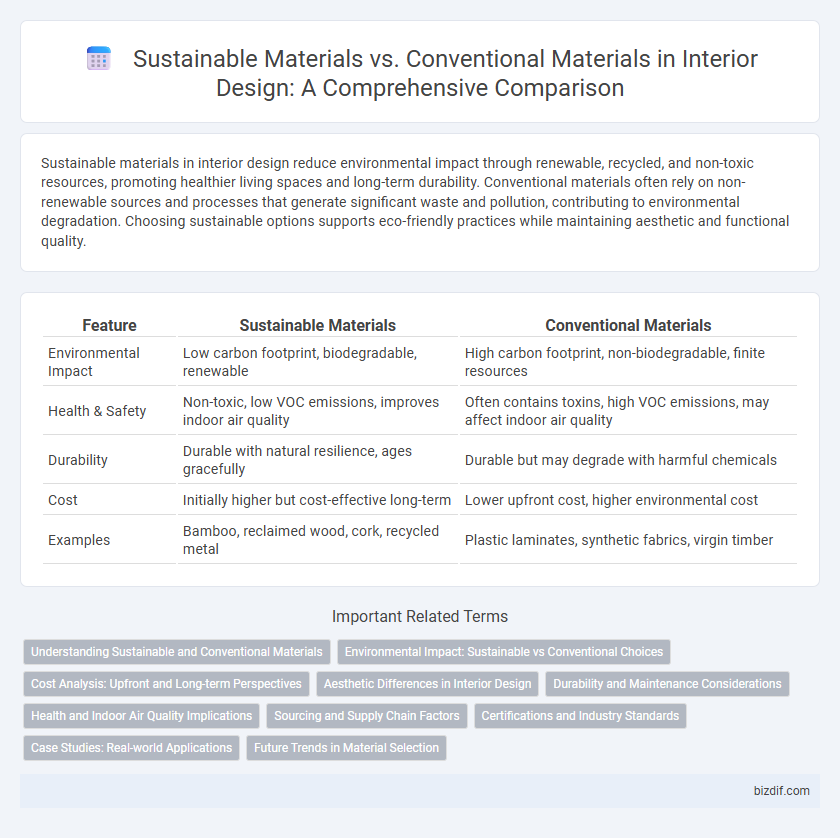Sustainable materials in interior design reduce environmental impact through renewable, recycled, and non-toxic resources, promoting healthier living spaces and long-term durability. Conventional materials often rely on non-renewable sources and processes that generate significant waste and pollution, contributing to environmental degradation. Choosing sustainable options supports eco-friendly practices while maintaining aesthetic and functional quality.
Table of Comparison
| Feature | Sustainable Materials | Conventional Materials |
|---|---|---|
| Environmental Impact | Low carbon footprint, biodegradable, renewable | High carbon footprint, non-biodegradable, finite resources |
| Health & Safety | Non-toxic, low VOC emissions, improves indoor air quality | Often contains toxins, high VOC emissions, may affect indoor air quality |
| Durability | Durable with natural resilience, ages gracefully | Durable but may degrade with harmful chemicals |
| Cost | Initially higher but cost-effective long-term | Lower upfront cost, higher environmental cost |
| Examples | Bamboo, reclaimed wood, cork, recycled metal | Plastic laminates, synthetic fabrics, virgin timber |
Understanding Sustainable and Conventional Materials
Sustainable materials in interior design prioritize environmental impact by using renewable, recycled, or low-emission resources such as bamboo, reclaimed wood, and natural fibers, reducing carbon footprints and waste. Conventional materials like plastic, synthetic fabrics, and non-renewable resources often involve higher energy consumption and pollutant emissions during production, contributing to long-term environmental degradation. Understanding the differences enables designers to make informed choices that balance aesthetics, durability, and ecological responsibility.
Environmental Impact: Sustainable vs Conventional Choices
Sustainable materials in interior design significantly reduce environmental impact by using renewable resources, lowering carbon emissions, and minimizing waste compared to conventional materials such as PVC and non-recycled plastics. Bamboo, reclaimed wood, and recycled metal contribute to healthier ecosystems and promote circular design principles by extending material lifecycles. Choosing sustainable over conventional materials supports energy-efficient production processes and helps combat deforestation, pollution, and resource depletion.
Cost Analysis: Upfront and Long-term Perspectives
Sustainable materials often exhibit higher upfront costs compared to conventional materials but provide significant long-term financial benefits through durability, energy efficiency, and reduced maintenance. Conventional materials may appear cost-effective initially but can incur higher expenses over time due to frequent replacement and environmental impact-related costs. Analyzing total cost of ownership highlights sustainable materials as economically advantageous for eco-conscious interior design projects.
Aesthetic Differences in Interior Design
Sustainable materials in interior design often feature natural textures, earthy tones, and unique imperfections that create a warm, organic aesthetic distinct from the uniform and polished look of conventional materials like laminate or synthetic composites. These eco-friendly options, such as reclaimed wood, bamboo, and recycled metals, offer a tactile richness and visual narrative that conventional materials typically lack. The choice between sustainable and conventional materials significantly influences the overall ambiance, with sustainable materials fostering a sense of authenticity and environmental consciousness.
Durability and Maintenance Considerations
Sustainable materials like bamboo and reclaimed wood offer exceptional durability with lower environmental impact compared to conventional materials such as hardwood and synthetic composites, which often require more frequent replacement and higher maintenance costs. These eco-friendly alternatives resist wear and moisture effectively, reducing the need for harsh chemical treatments and extensive upkeep. Prioritizing sustainable materials enhances long-term resilience while minimizing maintenance efforts and ecological footprint in interior design projects.
Health and Indoor Air Quality Implications
Sustainable materials such as bamboo, cork, and reclaimed wood significantly improve indoor air quality by reducing the emission of volatile organic compounds (VOCs) compared to conventional materials like plywood and particleboard. These eco-friendly options promote healthier living environments by minimizing exposure to toxic chemicals, allergens, and pollutants commonly found in synthetic paints, adhesives, and finishes. Choosing sustainable materials supports better respiratory health and overall wellness through enhanced natural ventilation and moisture regulation.
Sourcing and Supply Chain Factors
Sustainable materials in interior design prioritize eco-friendly sourcing, often involving renewable resources and local supply chains that reduce carbon footprints and support ethical production practices. Conventional materials typically rely on extensive, global supply chains with higher environmental impacts due to resource depletion and transportation emissions. Examining the origin, extraction methods, and logistics of materials is essential for designing interiors that minimize waste and promote circular economy principles.
Certifications and Industry Standards
Sustainable materials in interior design often carry certifications such as FSC (Forest Stewardship Council), GREENGUARD, and Cradle to Cradle, ensuring environmentally responsible sourcing and low chemical emissions. Conventional materials typically lack these industry standards, which can lead to higher environmental impact and indoor air quality concerns. Adhering to recognized certifications promotes healthier indoor environments and supports global sustainability goals in construction and design practices.
Case Studies: Real-world Applications
Case studies in interior design demonstrate that sustainable materials such as bamboo, recycled wood, and low-VOC paints improve indoor air quality while reducing environmental impact compared to conventional materials like hardwood and synthetic coatings. Projects utilizing reclaimed wood flooring and cork wall panels highlight energy-efficient benefits and longer lifespan, contributing to cost savings over time. These real-world applications emphasize the practicality and aesthetic appeal of sustainable materials in both residential and commercial interiors.
Future Trends in Material Selection
Emerging sustainable materials such as bamboo, recycled metal, and low-VOC composites are transforming interior design by reducing environmental impact and improving indoor air quality. Future trends emphasize circular economy principles, prioritizing materials that are renewable, biodegradable, and have a minimal carbon footprint over conventional options like hardwood, plastic, and synthetic fibers. Technological advancements in bio-based and smart materials further enhance durability and functionality, setting a new standard for eco-conscious interior spaces.
Sustainable materials vs Conventional materials Infographic

 bizdif.com
bizdif.com